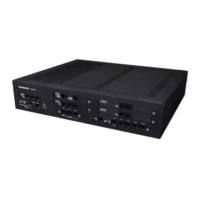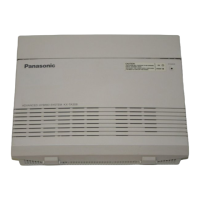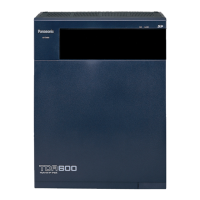c. Extensions in Tenant 3 are either COS 5 or 6. They can access trunk groups 5 and 6.
Trunk
Group 1
Trunk
Group 2
Trunk
Group 3
Trunk
Group 4
Trunk
Group 5
Trunk
Group 6
COS 1 COS 2
Extension User
Group 1
Tenant 1
Extn. 100 Extn. 101
Extension User
Group 2
Extn. 103Extn. 102
COS 4COS 3
Extension User
Group 3
Tenant 2
Extn. 104 Extn. 105
Extension User
Group 4
Extn. 107Extn. 106
COS 5 COS 6
Extension User
Group 5
Tenant 3
Extn. 108 Extn. 109
Extension User
Group 6
Extn. 111Extn. 110
PBX
Conditions
• One-look Networking (® 14.1.4 One-look Network)
For features whose operation depends on Time Service
(® 19.1.3 Time Service), system programming
specifies which PBX’s clock is used to determine the time mode.
® 14.6 PBX Configuration—[6-6] Feature—Tenant—
Time Service Mode
• ARS Assignment
When "On for Local Access Operation" or "On for Any CO Access Operation" is assigned
as the ARS Mode for a tenant, only a subset of the ARS Leading Number Table is applied to that tenant’s
outgoing calls. Tenants 1 to 20 are assigned a range of 50 of the entries in the Leading Number Table as
follows:
– Tenant 1: Entries 1 to 50
– Tenant 2: Entries 51 to 100
– Tenant 3: Entries 101 to 150
:
– Tenant 20: Entries 951 to 1000
If "Same as System Setting" is selected, then all 1000 entries in the table will be applied to that
tenant’s outgoing calls. All 1000 entries in the table are applied to tenants 21 to 32/128 when ARS is
enabled, regardless of the tenant’s ARS Mode.
By dividing tenants, specific ARS settings can be applied to specific tenants according to the requirements
of each tenant.
The following example illustrates how the ARS Leading Number Table is applied to tenants:
Tenant No. ARS Mode Applied ARS Entries
1 On for Local Access Operation Entries 1 to 50
2 Off Not applied
370 Feature Manual Document Version 2016-03
19.1.2 Tenant Service

